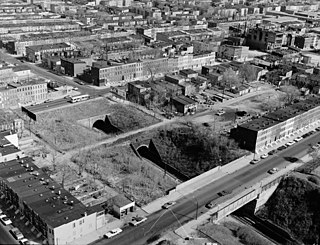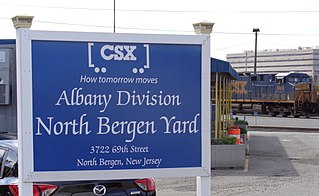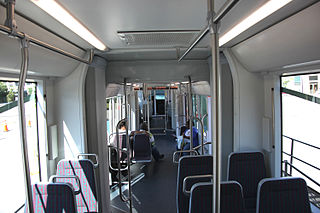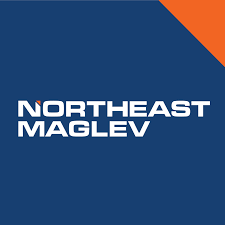
Washington Union Station is a major train station, transportation hub, and leisure destination in Washington, D.C. Designed by Daniel Burnham and opened in 1907, it is Amtrak's headquarters, the railroad's second-busiest station, and North America's ninth-busiest railroad station. The station is the southern terminus of the Northeast Corridor, an electrified rail line extending north through major cities including Baltimore, Philadelphia, New York City, and Boston, and the busiest passenger rail line in the nation. In 2015, it served just under 5 million passengers.

The Orange Line is a rapid transit line of the Washington Metro system, consisting of 26 stations in Fairfax County and Arlington, Virginia; the District of Columbia; and Prince George's County, Maryland, United States. The Orange Line runs from Vienna in Virginia to New Carrollton in Maryland. Half of the line's stations are shared with the Blue Line and over two thirds are shared with the Silver Line. Orange Line service began on November 20, 1978.

Interstate 395 (I-395) in Washington D.C. and Virginia is a 13.79-mile-long (22.19 km) spur route of I-95 that begins at an interchange with I-95 in Springfield and ends at an interchange with US Route 50 (US 50) in Northwest Washington, D.C. It passes underneath the National Mall near the US Capitol and ends at a junction with US 50 at New York Avenue, roughly one mile (1.6 km) north of the 3rd Street Tunnel. Despite its proximity to I-395 in Maryland, the route is unrelated and unconnected.

The Southeast Corridor (SEC) is a proposed passenger rail transportation project in the Mid-Atlantic and Southeastern United States to extend high-speed passenger rail services from Washington, D.C. south through Richmond, Petersburg with a spur to Norfolk in Virginia through Raleigh, Durham, Greensboro and south to Charlotte in North Carolina and connect with the existing high-speed rail corridor from D.C. to Boston, Massachusetts known as the Northeast Corridor. Since first established in 1992, the U.S. Department of Transportation (USDOT) has extended the corridor to Atlanta, Georgia and Macon, Georgia; Greenville, South Carolina; Columbia, South Carolina; Jacksonville, Florida; and Birmingham, Alabama.
The Northern Branch Corridor Project is a proposed extension of the Hudson-Bergen Light Rail (HBLR) from its northern terminus into eastern Bergen County, New Jersey, initially proposed in 2001. If built, the new service would use the right-of-way of the Northern Branch on which the Erie Lackawanna Railroad ran passenger service until October 3, 1966, and is currently a lightly used, stub-ended freight rail line owned by CSX Transportation. The Northern Branch Corridor is at the foot of the west side of the Hudson Palisades in the Hackensack River valley, running for much of its length parallel to Overpeck Creek. After mixed reactions and extensive community input to a draft environmental impact statement (EIS), it was decided in 2013 to terminate the line at the Englewood Hospital and Medical Center. In March 2017 the Supplementary Draft Environmental Impact Statement was approved by the Federal Transit Administration allowing for a period of public reaction. A separately-conceived and funded bridge at 69th St. in North Bergen, necessary for operation of the system, has been completed. In 2017 NJ Transit estimated that the line would open in 2029.
The Cross-Harbor Rail Tunnel is a proposed freight rail transport tunnel under Upper New York Bay in the Port of New York and New Jersey between northeastern New Jersey and Long Island, including southern and eastern New York City.
The Baltimore–Washington Superconducting Maglev Project (SCMAGLEV) is a proposed project connecting the United States cities of Baltimore, Maryland, and Washington, D.C., with a 40 mi (64 km) maglev train system between their respective central business districts. It is the first segment of the planned Washington-New York Northeast Maglev project. The maglev proposal is not related to the Baltimore–Washington hyperloop proposed by the Boring Company.

Petersburg station is an Amtrak railroad station located at 3516 South Street in Ettrick, Virginia just outside the city of Petersburg. However, like most of Ettrick, it has a Petersburg address. The station was built in 1955 by the Atlantic Coast Line Railroad (ACL) and services nearby Virginia State University and its home field, Rogers Stadium, both a short walk from the station.

The Cumberland Subdivision is a railroad line owned and operated by CSX Transportation in the U.S. states of Maryland and West Virginia. The line runs from Brunswick, Maryland, west to Cumberland, Maryland, along the old Baltimore and Ohio Rail Road (B&O) main line. At its east end, the Cumberland Subdivision becomes the Metropolitan Subdivision; at its west end at Cumberland, Maryland it becomes the Cumberland Terminal Subdivision. It meets the Shenandoah Subdivision at Harpers Ferry, West Virginia, and the Lurgan Subdivision at Cherry Run, West Virginia.

The Baltimore and Potomac Tunnel is a double-tracked, masonry arch railroad tunnel on the Northeast Corridor in Baltimore, Maryland, just south of Pennsylvania Station. Opened in 1873, the tunnel is used by about 140 Amtrak and MARC passenger trains and two freight trains every day, as of 2008.
National Gateway is a multi-stage railroad construction project in the United States promoted by CSX Transportation, a unit of CSX Corporation. It is designed to improve rail connections between ports in the U.S. mid-Atlantic seaboard and the Midwest by upgrading bridges and tunnels to allow taller freight trains. In 2008 the company announced its plans to invest $300 million, and is seeking investment from state governments and the U.S. federal government of an additional $400 million as a public-private partnership. Phase 1 of the $850 million project, between CSX's existing terminal in Chambersburg, Pennsylvania, and its hub facility in Northwest Ohio. was completed in September 2013.
The RF&P Subdivision is a railroad line owned and operated by CSX Transportation. It runs from Washington, D.C., to Richmond, Virginia, over lines previously owned by the Pennsylvania Railroad and the Richmond, Fredericksburg and Potomac Railroad. The line's name pays homage to that railroad, which was a predecessor to the CSX.

Potomac Yard station is a Washington Metro station under construction in Alexandria, Virginia, United States. The station will be operated by the Washington Metropolitan Area Transit Authority (WMATA), serving both the Blue and Yellow Lines, and is expected to open in May 2023. The station will be located at Alexandria's planned 7.5-million-square-foot (700,000 m2) Potomac Yard mixed-use development bounded by Richmond Highway and the George Washington Memorial Parkway. Upon its completion, Potomac Yard will be the second infill station to be added to the Washington Metro system, after NoMa–Gallaudet U in 2004. Potomac Yard station is being constructed on the site of Potomac Yard, a former railroad freight yard.

East Taunton station is an under-construction MBTA Commuter Rail station in East Taunton, Massachusetts adjacent to the interchange between the Route 24 expressway and County Street. It is planned to open in late 2023 as part of the first phase of the South Coast Rail project.
The Dighton and Somerset Railroad, currently referred to as the Dean Street Industrial Track, is a railroad that ran between Fall River and Braintree, Massachusetts. It opened in 1866; from the 1890s to the 1930s and again in the late 1950s, it was the primary rail route from Boston to the South Coast. Passenger service ended in stages with the final regular service in 1958, though freight service on two short segments continues into the 21st century. MBTA Commuter Rail service is proposed to be extended onto the northern part of the line around 2030 as part of the South Coast Rail project.

The North Bergen Yard is freight rail yard and intermodal terminal in North Bergen, New Jersey parallel to Tonnelle Avenue between 49th and 69th Streets. Located within the North Jersey Shared Assets Area, the facility is part of CSX Transportation (CSXT) and the origination point of its CSX River Subdivision at the southern end of the Albany Division. On its west side, the New York, Susquehanna and Western Railway (NYSW) runs the length of the yard and operates a bulk transloading operation immediately adjacent to it.

Long Bridge is the common name used for a series of three bridges connecting Washington, D.C. to Arlington, Virginia over the Potomac River. The first was built in 1808 for foot, horse and stagecoach traffic. Bridges in the vicinity were repaired and replaced several times in the 19th century. The current bridge was built in 1904 and substantially modified in 1942 and has only been used for railroad traffic. It is owned by CSX Transportation and is used by CSX freight trains, Amtrak intercity trains and Virginia Railway Express commuter trains. Norfolk Southern Railway has trackage rights on the bridge but does not exercise those rights. In 2019 Virginia announced that it would help fund and build a new rail bridge parallel to the existing one to double its capacity, following the plans that have been studied by the District Department of Transportation (DDOT) and Federal Railroad Administration (FRA) since 2011.

The Anacostia Line is a partially constructed line of the DC Streetcar, never put into service, intended to connect the Anacostia neighborhood with Joint Base Anacostia–Bolling. Construction occurred in 2009 and 2010, but was terminated before the line was complete.

Northeast Maglev or The Northeast Maglev, LLC, is a private U.S. company proposing a Superconducting Maglev (SCMAGLEV) train system in the Northeastern United States. Using technology developed by the Central Japan Railway Company, the Northeast Maglev would provide 15-minute service between Baltimore and Washington, D.C. with an intermediate stop at BWI Airport, and ultimately connect major Northeast metropolitan hubs and airports with a goal of one-hour service from Washington, D.C. to New York City.
69th Street is a proposed interchange station in North Bergen in Hudson County, New Jersey. It would serve passengers on two lines under consideration by NJ Transit, the Passaic–Bergen–Hudson Transit Project and the Northern Branch Corridor Project, the latter of which is an extension of the Hudson–Bergen Light Rail. The station would located at-grade west the North Bergen Yard and Tonnelle Avenue.













